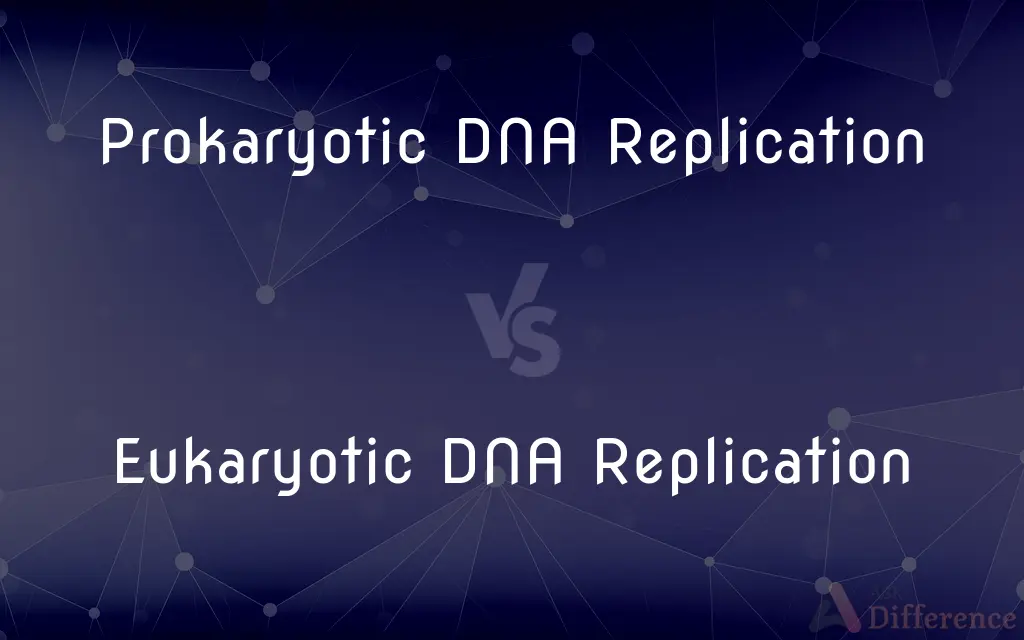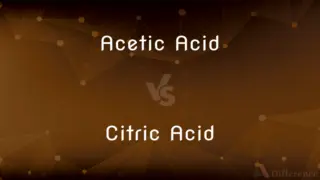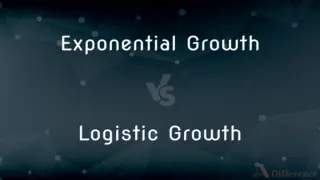Prokaryotic DNA Replication vs. Eukaryotic DNA Replication — What's the Difference?
By Tayyaba Rehman — Published on January 10, 2024
Prokaryotic DNA replication occurs in a simple, circular chromosome, typically starting from a single origin, while eukaryotic DNA replication occurs in complex, linear chromosomes, starting at multiple origins.

Difference Between Prokaryotic DNA Replication and Eukaryotic DNA Replication
Table of Contents
ADVERTISEMENT
Key Differences
Prokaryotic DNA replication is a simpler process due to the typically single, circular chromosome present in such organisms. It begins at a single point, the origin of replication, and proceeds bi-directionally until the entire molecule is copied. Eukaryotic DNA replication is more complex, involving linear chromosomes with multiple origins of replication to ensure the entire genome is duplicated in a timely manner.
The enzymes involved in prokaryotic DNA replication, such as DNA polymerase III, are different from those in eukaryotes, which include DNA polymerases α, δ, and ε. Eukaryotic DNA replication also involves more complex regulation and a higher-order chromatin structure, requiring additional factors to assist in unwinding and repackaging DNA.
Prokaryotic DNA replication can occur very rapidly, with the process being completed in as little as 40 minutes in bacteria like E. coli. In contrast, eukaryotic DNA replication takes a much longer time due to the larger amount of DNA and the intricacies of chromatin structure.
Chromosomal replication in prokaryotes is often coupled with cell division, meaning that replication directly leads to the division of the cell. In eukaryotes, DNA replication is part of a more complex cell cycle, where replication only occurs during the S phase, followed by a series of checkpoints and balances before the cell can divide.
Prokaryotic DNA replication is robust and quick, which supports the fast growth rates of bacteria. Eukaryotic DNA replication, while slower, has built-in mechanisms for proofreading and error correction, contributing to the stability of the genomes of more complex organisms.
ADVERTISEMENT
Comparison Chart
Chromosome Structure
Single, circular chromosome
Multiple, linear chromosomes
Origin of Replication
Single origin
Multiple origins
Speed of Replication
Rapid
Slower
Replication Machinery
Simpler enzymes
More complex enzymes
Association with Cell Division
Directly coupled with cell division
Part of a complex cell cycle
Compare with Definitions
Prokaryotic DNA Replication
Occurs almost continuously in fast-growing bacteria.
Escherichia coli undergoes prokaryotic DNA replication every 20 minutes.
Eukaryotic DNA Replication
The replication process of linear DNA in eukaryotic chromosomes.
Eukaryotic DNA replication is essential before cell division.
Prokaryotic DNA Replication
The process of duplicating a prokaryote’s circular DNA.
Prokaryotic DNA replication ensures bacterial cells can divide quickly.
Eukaryotic DNA Replication
Involves multiple origins of replication for each chromosome.
Eukaryotic DNA replication begins at several points to expedite the process.
Prokaryotic DNA Replication
Lacks the complexity of chromatin remodeling seen in eukaryotes.
Prokaryotic DNA replication doesn’t require extensive chromatin remodeling.
Eukaryotic DNA Replication
Includes intricate checkpoint systems for accuracy.
The fidelity of eukaryotic DNA replication is maintained by strict checkpoints.
Prokaryotic DNA Replication
Originates from a single starting point on the chromosome.
Prokaryotic DNA replication begins at the unique origin of replication.
Eukaryotic DNA Replication
Characterized by complex chromatin structure and unpacking.
Chromatin has to be unpacked during eukaryotic DNA replication.
Prokaryotic DNA Replication
Involves fewer regulatory sequences than eukaryotic replication.
The simplicity of prokaryotic DNA replication allows for rapid bacterial growth.
Eukaryotic DNA Replication
Requires a suite of specialized replication enzymes.
DNA polymerase delta is crucial for eukaryotic DNA replication.
Common Curiosities
Can eukaryotic DNA replication occur throughout the cell cycle?
No, it occurs only during the S phase of the cell cycle.
What is the key structural difference affecting prokaryotic vs. eukaryotic DNA replication?
Prokaryotes have circular DNA, eukaryotes have linear DNA with complex chromatin.
Why is eukaryotic DNA replication more complex?
Eukaryotic genomes are larger and involve more intricate packaging and regulatory sequences.
Are the enzymes the same for prokaryotic and eukaryotic DNA replication?
No, each uses different enzymes suitable for their replication processes.
How does the origin of replication differ between prokaryotic and eukaryotic cells?
Prokaryotes have a single origin, while eukaryotes have multiple origins.
Do antibiotics that inhibit prokaryotic DNA replication affect eukaryotes?
Most do not because they target processes unique to prokaryotes.
What happens if errors occur during DNA replication in prokaryotes vs. eukaryotes?
Both have mechanisms to correct errors, but eukaryotic cells have more complex systems.
Is prokaryotic DNA replication faster than eukaryotic?
Yes, generally it is due to the smaller genome and simpler processes.
How do cells ensure that DNA replication is only initiated once per cell cycle in eukaryotes?
Through the use of licensing factors that control the assembly of the replication machinery.
Do prokaryotes have telomeres that need replicating?
No, telomeres are a feature of eukaryotic linear chromosomes.
How does cell division relate to DNA replication in prokaryotes?
In prokaryotes, cell division immediately follows DNA replication.
Are the regulatory mechanisms for DNA replication the same in prokaryotes and eukaryotes?
No, eukaryotes have more complex regulatory mechanisms due to their larger genomes and multicellularity.
Does prokaryotic DNA replication involve a primer?
Yes, both types of replication require a primer to initiate DNA synthesis.
What is the role of chromatin in eukaryotic DNA replication?
Chromatin must be unpacked to allow the replication machinery access to DNA.
What ensures the accuracy of DNA replication in eukaryotic cells?
Proofreading functions of DNA polymerases and post-replication repair mechanisms.
Share Your Discovery

Previous Comparison
Acetic Acid vs. Citric Acid
Next Comparison
Exponential Growth vs. Logistic GrowthAuthor Spotlight
Written by
Tayyaba RehmanTayyaba Rehman is a distinguished writer, currently serving as a primary contributor to askdifference.com. As a researcher in semantics and etymology, Tayyaba's passion for the complexity of languages and their distinctions has found a perfect home on the platform. Tayyaba delves into the intricacies of language, distinguishing between commonly confused words and phrases, thereby providing clarity for readers worldwide.












































